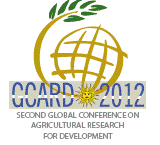Gender in Agriculture Partnership (GAP)
[News]

GAP’s initial deliverables could include:
a) Setting up a sub-group of GAP members with links to the ground at national and regional levels (CSOs, NARS, Farmer Organizations, SMEs, Regional Fora etc) to develop advocacy messages supported with data and share these with other stakeholders;
b) Presenting the GCWA conclusions and recommendations at GCARD2, with emphasis on recent data estimating the costs of neglecting women and benefits to be gained from closing the gender gap in AR4D;
c) Sharing tangible examples at GCARD2 of how gender equity policies and actions have addressed agricultural constraints effectively with detail on how they work and why;
d) Organizing a High-Level Plenary Panel at GCARD2, comprising world-renowned opinion leaders and executive heads of selected major global, regional and national AR4D organizations, to discuss and make recommendations on gender/women issues in AR4D; and
e) Advocating in GCARD2 plenary and parallel sessions for resources to build the evidence base on the advantages of closing the gender gap in access to assets, services, technologies, communication and information, transport etc, and the costs of not doing so, at national, regional and global levels, by agricultural subsector value chains.

GAP is a multi-stakeholder network of institutions and individuals promoting gender equity and women’s empowerment in the agricultural sector in order to increase production and productivity, value-addition and increases in incomes, reduce losses and wastage, and ensure food and nutrition security, particularly at the household level. Such an approach requires the re-conceptualization of agriculture as a vehicle for household and community well-being rather than just economic growth.
The GAP partnership has its origins in a desire for greater attention to gender-related issues in agriculture, recognizing that, despite their importance, these are currently not receiving the attention they require at all levels. GAP has come together through the open and inclusive forum of GFAR, in particular; through actions of the 3 Rome-based agencies (FAO, IFAD and WFP) with mandates for agriculture, food and nutrition, gender specialists from the CGIAR system (IFPRI, AWARD and the Consortium Office’s Gender Unit), three Regional Fora (APAARI, AARINENA and FARA) and civil society networks such as DIMITRA (see Annex 1 for acronyms). The GFAR Secretariat has played an unique role to convene these partners and catalyze the process.
The GAP was launched through the First Global Conference on Women in Agriculture (GCWA), organized in New Delhi on March 13-15 by the Indian Council of Agricultural Research (ICAR) and the Asia-Pacific Association of Agricultural Research Institutions (APAARI), was supported through the Gender in Agriculture Partnership (GAP) of the multi-stakeholder Global Forum on Agricultural Research (GFAR). The Synthesis Report of the GCWA conference is available here.
GAP’s initial deliverables and their timeframe would be developed alongside a comprehensive participatory process, for discussion/recommendations at GCARD2. As GAP gathers strength, gains in membership and develops its governance mechanism, it would adopt a rolling process for discussing and agreeing on future deliverables.
GAP’s initial deliverables could include:
Firm, public commitments made at GCARD2 by policy makers, AR4D organization leaders and donors to adopt policies and allocate resources for large-scale gender-equitable AR4D
Activities to achieve this deliverable include GAP members contributing to:
a) Setting up a sub-group of GAP members with links to the ground at national and regional levels (CSOs, NARS, Farmer Organizations, SMEs, Regional Fora etc) to develop advocacy messages supported with data and share these with other stakeholders;
b) Presenting the GCWA conclusions and recommendations at GCARD2, with emphasis on recent data estimating the costs of neglecting women and benefits to be gained from closing the gender gap in AR4D;
c) Sharing tangible examples at GCARD2 of how gender equity policies and actions have addressed agricultural constraints effectively with detail on how they work and why;
d) Organizing a High-Level Plenary Panel at GCARD2, comprising world-renowned opinion leaders and executive heads of selected major global, regional and national AR4D organizations, to discuss and make recommendations on gender/women issues in AR4D; and
e) Advocating in GCARD2 plenary and parallel sessions for resources to build the evidence base on the advantages of closing the gender gap in access to assets, services, technologies, communication and information, transport etc, and the costs of not doing so, at national, regional and global levels, by agricultural subsector value chains.
Find more information on the GAP here.
Posted on 12/10/2012
Tweet
